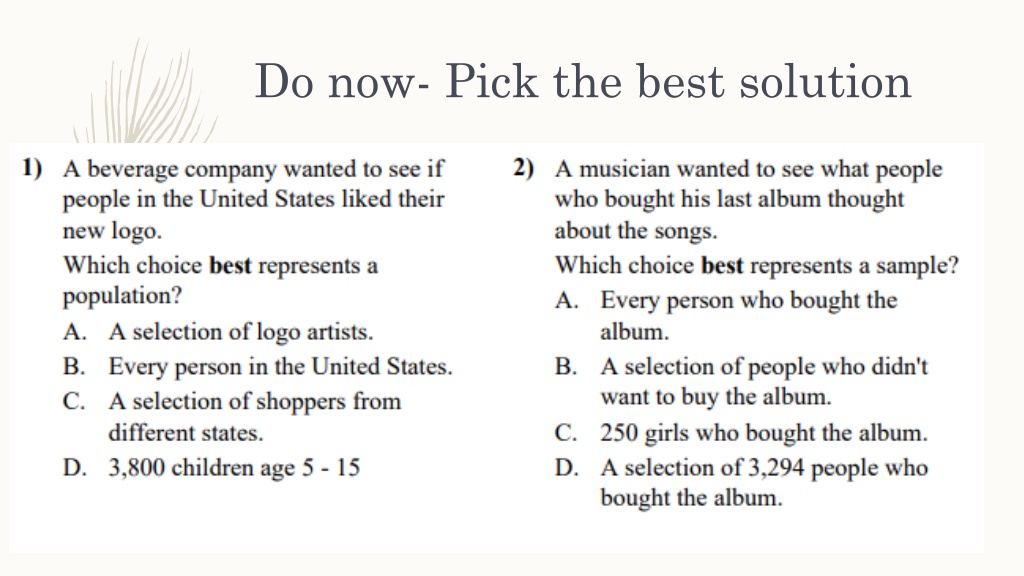Sampling Methods and Techniques
Learn about the differences between stratified random sampling and cluster sampling techniques, their advantages, and how to implement them effectively in surveys and data collection. Understand the importance of selecting a sample that accurately represents the population being studied, and discover practical examples to enhance your understanding.
Download Presentation

Please find below an Image/Link to download the presentation.
The content on the website is provided AS IS for your information and personal use only. It may not be sold, licensed, or shared on other websites without obtaining consent from the author. Download presentation by click this link. If you encounter any issues during the download, it is possible that the publisher has removed the file from their server.
E N D
Presentation Transcript
Lesson 4.1 More Sampling Methods
Objectives Describe how to select a sample using stratified random sampling and cluster sampling, distinguish stratified random sampling from cluster sampling, and give an advantage of each method.
Definitions Stratified Random Sample: splits population into groups (strata) and chooses an SRS from each group Cluster Sampling: split population into groups based on location (clusters) and randomly select clusters. Take everyone in cluster.
Important Concepts A stratified random sample can be more effective than a simple random sample because it reduces the variability in the sampling distribution. When choosing the variable to use for stratifying (row or column), pick the one that most reduces the variability in the sampling distribution or the one that is most strongly associated with the response variable (enjoyment). Stratified random samples take an SRS from each strata, while a cluster sample takes a random sample of clusters then uses all individuals in the selected clusters.
Example The student council wants to conduct a survey during the first five minutes of an all-school assembly in the auditorium about use of the school library. They would like to announce the results of the survey at the end of the assembly. The student council president asks your statistics class to help carry out the survey.
There are 800 students present at the assembly. A map of the auditorium is shown on the next page. Note that students are seated by grade level and that the seats are numbered from 1 to 800. How you would use your calculator to select 80 students to complete the survey using an SRS?
Solution To take an SRS, we need to choose 80 of the seat numbers at random. Use randInt(1,800,80) on your calculator until 80 different seats are selected. Then give the survey to the students in those seats.
There are 800 students present at the assembly. A map of the auditorium is shown on the next page. Note that students are seated by grade level and that the seats are numbered from 1 to 800. How you would use your calculator to select 80 students to complete the survey using a stratified random sample?
Solution The students in the assembly are seated by grade level. Because students library use might be similar within grade levels but different across grade levels, we ll use the grade level seating areas as our strata. Within each grade s seating area, we ll select 20 seats at random. For the 9th grade, use randInt(601,800,20) to select 20 different seats. Use randInt(401,600,20) to pick 20 different sophomore seats, randInt(201,400,20) to get 20 different junior seats, and randInt(1,200) to choose 20 different senior seats. Give the survey to the students in the selected seats.
There are 800 students present at the assembly. A map of the auditorium is shown on the next page. Note that students are seated by grade level and that the seats are numbered from 1 to 800. How you would use your calculator to select 80 students to complete the survey using cluster sample?
Solution With the way students are seated, each column of seats from the stage to the back of the auditorium could be used as a cluster. Note that each cluster contains students from all four grade levels, so each should represent the population well. Because there are 20 clusters, each with 40 seats, we need to choose 2 clusters at random to get 80 students for the survey. Use randInt(1,20,2) to select two clusters, and then give the survey to all 40 students in each column of seats.























